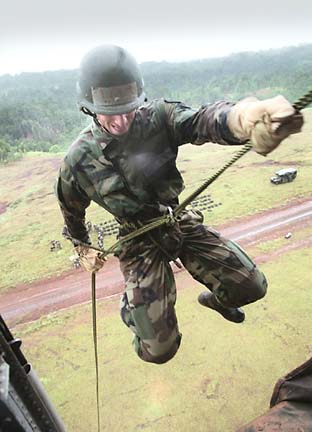


Earning their wings
The sky is the limit for
By Gregg K. Kakesako
soldiers in the 25th Infantry
Division's Air Assault School at
Schofield Barracks
Star-BulletinMore than 40,000 soldiers have sweated through the 25th Infantry Division's Air Assault School since it was established in the 1970s.
Their goal, after completing 10 days of rigorous physical training, is to receive silver air assault wings, which feature a helicopter in the middle.
"The training hasn't been changed since the wings were first awarded at Fort Campbell in Kentucky 25 years ago by the 101st Airborne Division," said 1st Sgt. Gregory Banton.
"Back then it was only a local award, but later it was changed so all soldiers could qualify for it," he said.

Banton said modifications through the past quarter-century have been done to the training curriculum mainly to accommodate the different types of helicopters and vehicles the Army now uses.Schofield Barracks' East Range Air Assault School is only one of three in the Army system. The others are located at Fort Campbell and Fort Drum in New York. The Schofield Barracks school conducts 16 classes a year on Oahu and the air assault's mobile training teams deploy several times a year to run the 10-day course at other locations.

Students are required to complete three phases -- pathfinder, sling-loading and rappelling -- and finish a 12-mile march carrying a 35-pound pack in under three hours before being allowed to pin on the air assault wings.Each phase is about three days long. During the rappelling phase the soldiers start on a 12-foot slanted wall, Banton said, and gradually work up to a 45-foot tower.
"The culmination is a 100-foot drop from an aircraft," he said.

